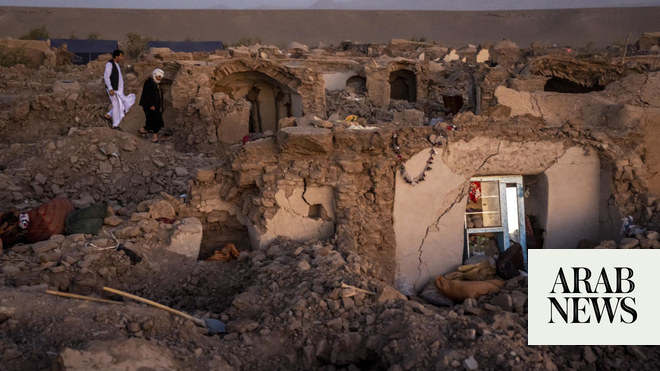Second earthquake in northwestern Afghanistan causes fresh damage

[ad_1]
ZINDA JAN, Afghanistan: Clinging to hope that finding survivors was still possible, Afghan rescuers and villagers kept digging through rubble in western Herat province on Tuesday, three days after one of the deadliest earthquakes in the region left more than 2,000 dead.
Elsewhere in Herat, people were digging graves for loved ones killed in Saturday’s 6.3 magnitude quake. On a barren field in the district of Zinda Jan, a bulldozer removed mounds of earth to clear space for a long row of graves.
“It is very difficult to find a family member from a destroyed house and a few minutes to later bury him or her in a nearby grave, again under the ground,” said Mir Agha, from the city of Herat, who had joined hundreds of volunteers to help the locals.
Across kilometers (miles) of dusty hills, there was little left of villages besides rubble and funerals.
In Naib Rafi, a village that previously had about 2,500 residents, people said that almost no one was still alive besides men who were working outside when the quake struck. Survivors worked all day with excavators to dig long trenches for mass burials.
Janan Sayiq, a spokesman for the Afghan Taliban government’s national disaster authority, said the quake killed and injured thousands but couldn’t provide a breakdown for the casualties. Earlier, Taliban officials said more than 2,000 had died across Herat.
The epicenter was about 40 kilometers northwest of the city of Herat, the provincial capital, the US Geological Survey said. Several of the aftershocks have been strong, including one on Monday that caused residents of the city to rush out of their homes once again.
The United Nations said the Zinda Jan district was the worst-affected area, with 1,294 deaths and 1,688 injuries. In addition, 485 people — 191 men and 294 women — are missing. Six schools are also reported to have been destroyed, said the UN.
Nearly 2,000 houses in 20 villages were destroyed, the Taliban have said. The area hit by the quake has just one government-run hospital.
As winter approaches, the new disaster is likely to make it even harder for people to meet basic needs, such as shelter, food and medicine, aid groups have warned.
It is not clear how much foreign aid has reached Herat since Saturday. The global response has been slow. Much of the world is wary of dealing directly with the Taliban-led government and focused on the deadly escalation between Israel and the Palestinians in the aftermath of the surprise attack by Gaza militants on Saturday.
Pakistan has pledged to send blankets, tents, and medicines, and China is reported to have offered cash and other forms of emergency humanitarian assistance.
Other foreign governments said they will work with aid agencies on the ground to help with rescue and recovery, and Afghans have launched fundraising campaigns.
Authorities in Kabul did not respond to questions about how much aid has arrived from overseas. In a statement, the International Federation of Red Cross and Red Crescent Societies urged the media not to turn away from Afghanistan. “Your reporting can bring back attention to Afghanistan and the Afghan people’s untold stories of resilience and need,” an IFRC statement said.
“Afghanistan needs you — now, more than ever. Please, let’s not add ‘forgotten’ to the long list of tragedies that this resilient nation has already endured,” IFRC spokesperson Tommaso Della Longa said in the statement.
The Taliban’s Justice Ministry has urged national and international charity foundations, businesses and Afghans to gather aid for the province.
[ad_2]
Source: Arab News




